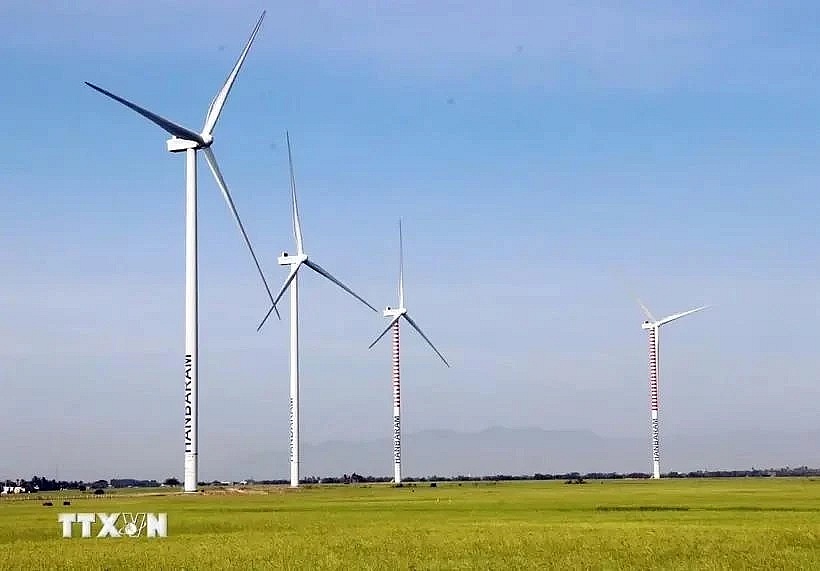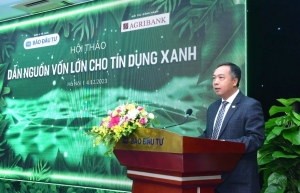Legal framework critical to boosting green credit
 |
| Turbines of the Hanbaram wind power project in Bac Phong commune of Thuan Bac district, Ninh Thuan province (Illustrative photo: VNA) |
Hanoi – The recent amendment of the plan on green banking development in Vietnam is expected to create conditions for credit institutions to effectively promote green credit.
Green growth and sustainable development is now an inevitable trend and a goal that all countries are striving for, including Vietnam, as it faces environmental problems heavily impacted by climate change.
During 2017 - 2023, the banking system’s green credit increased by about 22% annually. Many credit institutions have designed green credit packages and programmes tailored to the specific activities of businesses.
As of the start of 2024, outstanding green credit was estimated at 500 trillion VND (over 20.3 billion USD), accounting for only 4.5% of total banking credit, still falling short of expectations.
There remain many barriers to green credit supply. Among them, there is still a lack of green taxonomy – a basis for the State Bank of Vietnam (SBV) to evaluate the effectiveness of the credit solutions to realise the national green growth target. This is also an important basis for credit institutions to identify investment levels while designing suitable banking products and services.
In particular, there is no legal and policy framework pertaining to the implementation of green credit and sustainable finance.
Nguyen Duc Lenh, Deputy Director of the SBV branch in Ho Chi Minh City, said regulation amendments are necessary for facilitating access to green credit to develop green projects.
General Director of the Military Commercial Joint Stock Bank (MBBank) Pham Nhu Anh said the proportion of green credit in his bank is high, about 11% in 2023.
Interest rates for green credit is currently 0.5 - 2% per year lower than normal ones, but not many enterprises have accessed this type of credit, he noted.
He pointed out that since there is no clear legal framework on the national green taxonomy to provide green credit, MBBank applies the environmental, social and governance (ESG) standards. This includes the reduction of greenhouse gas emissions by at least 20%, along with standards to assess company performance in providing green credit.
Lim Dyi Chang, Senior Director for Corporate Clients at the United Overseas Bank (UOB) Vietnam, said it is not easy to identify good projects to provide green financing. Apart from business adoption of ESG practices, the bank also considers the human factor, and business impact on the environment before making credit decisions.
To help address these problems, in early August, the SBV issued Decision 1663/2024 that amends and supplements some articles of its Governor’s Decision 1604/2018 to approve the plan on green banking development in Vietnam. Some contents related to green banking, green credit, and tasks of relevant organisations and units are among the revised items.
The newly issued decision supplements a regulation that the SBV shall regularly update the list of green projects. It also details responsibilities for State agencies, including releasing guidance on green credit and environmental risk management, issuing guidance on the compilation of green credit reports, and building reference documents for credit institutions so as to create a consistent legal basis for the institutions to carry out in reality.
Dr Can Van Luc, Chief Economist of the Bank for Investment and Development of Vietnam (BIDV), said from now to 2040, the country needs to mobilise about 368 - 380 billion USD, equivalent to 20 billion USD each year, for green development. Given this, the legal framework perfection will open up opportunities for credit institutions to fully tap into potential in this field.
 | Positive signs in Vietnam's green credit sector 'Green credit' refers to the kinds of loans provided by banks for projects that are considered environmentally friendly or protective of the ecosystem. Green credit is now a trend in the global banking and finance industry, and more Vietnamese banks are following suit. |
 | Agribank's green finance initiative: Catalysing Vietnam's eco-friendly economic ascent At the forefront of Vietnam's green finance revolution, Agribank has reported a substantial green credit portfolio of approximately $510 million as of October 31. This revelation came from Phung Thi Binh, deputy general director of Agribank, during the Lighting the Path for Green Financing seminar held by VIR on December 4. |
 | Vietnam's green credit surge: Navigating towards sustainable finance At a VIR seminar on December 4, in collaboration with the Vietnam Bank for Agriculture and Rural Development (Agribank), key stakeholders congregated to discuss Lighting the Path for Green Financing. The forum signified a critical juncture in Vietnam's path towards sustainable development and emphasised green economic growth. |
 | Standard Chartered and BIDV sign $100 million sustainable trade loan agreement Standard Chartered has inked a Master of Agreement with the Bank for Investment and Development of Vietnam (BIDV), committing to a sustainable trade loan of up to $100 million. |
What the stars mean:
★ Poor ★ ★ Promising ★★★ Good ★★★★ Very good ★★★★★ Exceptional
Related Contents
Latest News
More News
- Heavy industries set for pilot greenhouse gas quotas (December 25, 2025 | 10:00)
- Swedfund invests in MSME growth and climate action in Vietnam (December 19, 2025 | 11:42)
- GreenYellow brings solar energy to light up remote schools in Tuyen Quang province (December 19, 2025 | 08:00)
- Charge+, Grab partner to develop EV charging network in Vietnam (December 18, 2025 | 17:11)
- Linking sci-tech and innovation to Vietnam’s net-zero future (December 18, 2025 | 14:31)
- Driving double-digit growth through green and circular transformation in Vietnam (December 17, 2025 | 09:00)
- Standard Chartered and ACCA deepen collaboration to develop Vietnam’s talent for a sustainable future (December 15, 2025 | 18:18)
- Schaeffler reports strong early output from Dong Nai solar project (December 12, 2025 | 15:16)
- Forestry conference highlights biodiversity and sustainability goals (December 09, 2025 | 13:35)
- Home Credit honoured among top 10 sustainable companies in trade and services (December 09, 2025 | 12:18)

 Tag:
Tag:




















 Mobile Version
Mobile Version